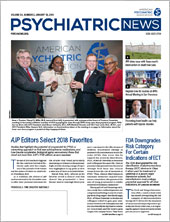FDA Names Companies for Innovation Challenge
The Food and Drug Administration (FDA) in November 2018 announced that eight companies were selected as beneficiaries in the Center for Devices and Radiological Health’s (CDRH) Innovation Challenge. The CDRH launched the challenge in May 2018 to spur the development of medical devices that could provide new solutions for detecting, treating, and preventing opioid addiction; addressing diversion; and treating pain.
The companies and products chosen were as follows:
•
Brainsway Ltd. (deep transcranial magnetic stimulation device)
•
Avanos (pain therapy device)
•
iPill Dispenser (tamper-resistant locked pill storage unit that dispenses medications at predetermined times)
•
Masimo Corporation (overdose detection device)
•
ThermoTek Inc. (devices for pain management)
•
Milliman (opioid prediction service)
•
Algomet Rx Inc. (rapid drug screen)
•
CognifiSense Inc. (virtual reality neuropsychological therapy)
The device developers will receive increased interaction with CDRH experts, guidance for clinical trial development plans, and expedited review. They will not automatically receive marketing authorization from the FDA.
Phase 2a Treatment Shows Promise for Cannabis Use Disorder
A long-acting fatty acid amide hydrolase (FAAH) inhibitor, PF-04457845, appears to help men with cannabis use disorder, according to a study in the January issue of the Lancet Psychiatry.
Deepak Cyril D’Souza, M.D., of the VA Connecticut Healthcare System in West Haven and colleagues randomly assigned 46 men with cannabis use disorder to receive the treatment and 24 men to placebo, stratified by severity of cannabis use and desire to quit. Participants were admitted to a hospital for five to eight days to achieve abstinence and start cannabis withdrawal, then discharged for the remaining three weeks of treatment.
After four weeks, the men in the treatment group reported smoking a mean of 0.40 joints per day compared with 1.27 joints per day for men in the placebo group. The men in the treatment group also had significantly lower urinary tetrahydrocannabinol carboxylic acid concentrations than those in the placebo group. There were no serious adverse events in either group.
“PF-04457845, a novel FAAH inhibitor, reduced cannabis withdrawal symptoms and cannabis use in men, and might represent an effective and safe approach for the treatment of cannabis use disorder,” D’Souza and colleagues wrote.
This study was funded by the National Institute on Drug Abuse.
D’Souza DC, Cortes-Briones J, Creatura G, et al. Efficacy and Safety of a Fatty Acid Amide Hydrolase Inhibitor (PF-04457845) in the Treatment of Cannabis Withdrawal and Dependence in Men: A Double-blind, Placebo-Controlled, Parallel Group, Phase 2a Single-Site Randomised Controlled Trial. Lancet Psychiatry. 2019;6(1):35-45.
Bedtime Prazosin May Worsen Nightmares in PTSD Patients
Taking prazosin at bedtime may worsen nightmares in patients with posttraumatic stress disorder (PTSD) and suicidal thoughts, according to a study published in the Journal of Clinical Psychopharmacology in December 2018.
In the study, 20 patients with PTSD and mild to moderate suicidal ideation were randomized to bedtime-only dosing of either prazosin or placebo for eight weeks.
Participants had weekly visits to receive the following week’s medication. Although treatment effects were not significant during the first four weeks, by the study’s end those in the prazosin group scored significantly higher than those in the placebo group on the Disturbing Dreams and Nightmare Severity Index. Similarly, people in the prazosin group showed less improvements on the Insomnia Severity Index and the Hamilton Rating Scale for Depression. Their scores also rose for the Scale of Suicide Ideation, although not as much as they did for the other indices. Suicidal ideation and daytime-only PTSD symptoms were similar in the prazosin group and placebo groups.
“The results do not support a larger study of nighttime-only prazosin in suicidal PTSD patients but leave open the possibility of benefit from daytime administration of prazosin,” the authors wrote.
McCall WV, Pillai A, Case D. A Pilot, Randomized Clinical Trial of Bedtime Doses of Prazosin Versus Placebo in Suicidal Posttraumatic Stress Disorder Patients With Nightmares. J Clin Psychopharmacol. 2018;38(6):618-621.
Phase 2 Results for PTSD Combo Therapy Suggest Efficacy
Patients with posttraumatic stress disorder (PTSD) appear to experience greater symptom improvements when taking a combination of brexpiprazole and sertraline than those taking either medication alone, suggest the findings of a phase 2 trial. H. Lundbeck and Otsuka Pharmaceutical Co. Ltd. announced the results last November.
The trial, which involved 321 patients, assessed the efficacy, safety, and tolerability of monotherapy with brexpiprazole, sertraline, or a combination of the two agents compared with placebo for 12 weeks. The patients were evaluated using the Clinician-Administered PTSD Scale for DSM-5 (CAPS-5) at the beginning and end of the trial. Those treated with both agents experienced improvement in their PTSD symptoms over time compared with those in the placebo group. Treatment with either agent alone did not demonstrate clinically meaningful differences compared with placebo.
According to a press statement by Lundbeck, the companies plan to discuss the results of the trial with the Food and Drug Administration (FDA) and to evaluate, with FDA, the continuation of a trial program. ■
Schizophrenia Drug Had Favorable Weight Profile in Phase 3 Trial
Alkermes announced last November the results from ENLIGHTEN-2, a phase 3 trial of its investigational schizophrenia drug ALKS 3831. Patients with schizophrenia who took ALKS 3831—a combination of olanzapine and the opioid receptor antagonist samidorphan—for six months did not gain as much weight as those taking olanzapine alone.
Patients in the ALKS 3831 group met both primary endpoints for the trial: they had a lower mean percent weight gain at six months compared with those in the olanzapine group, and a lower proportion of patients who gained 10 percent or more of their baseline body weight at six months.
The difference in weight gain between the two groups became apparent after the fourth week of the trial, and their rates of weight gain continued to diverge for the remainder of the study. At the sixth week, weight stabilized in the ALKS 3831 treatment group and remained flat for the rest of the study period.
Alkermes plans to submit a New Drug Application to the FDA later this year. ■
